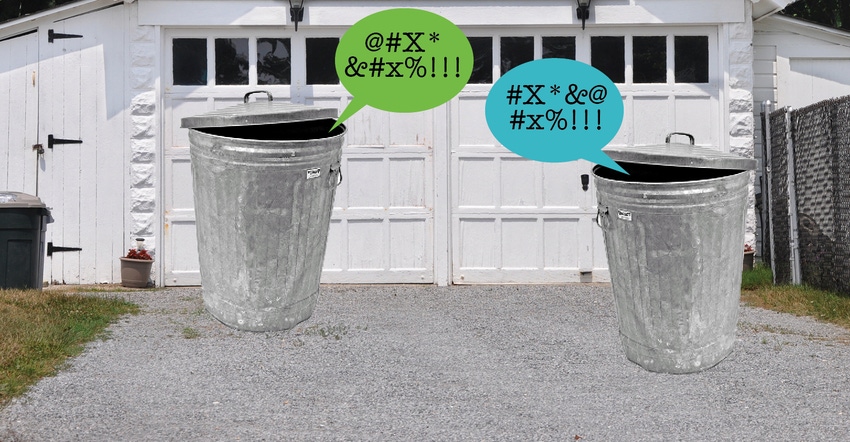In two separate trials, garbage was used as revenge, as a “weapon” of choice and to make a statement.
March 14, 2018

Robert Fulghum, author of “All I Really Need To Know I Learned in Kindergarten,” got it right. “Good neighbors make a huge difference in the quality of life,” he said. To illustrate, here are the trials (literally) and tribulations of purported adults whose behavior drew responses far more dramatic and consequential than a preschooler time-out.
Sarah Janecek and Lee Aaron and Diane Rosenthal have been next-door neighbors for more than a decade, sharing a common driveway. Over time, the relationship deteriorated to the point where they no longer spoke to each other, and the Rosenthals installed security cameras to monitor the outside of their home.
Janecek was charged with stalking, trespassing, disorderly conduct and littering. At her trial, the state introduced 17 videos into evidence, documenting a history of confrontations between the neighbors, from verbal altercations to property-line disputes. For example, an August 2013 video showed Janecek returning her garbage can to the common area between the neighbors' garages. After doing so, she pushes the Rosenthals' recycling bin forward and knocks over their trash bin, spilling debris onto their side of the driveway. She then returns another one of her bins and walks away.
On the witness stand, Janecek confessed that she pushed the Rosenthals' containers and littered their driveway. She also admitted that on different occasions she had moved the Rosenthals' containers and a fallen tree branch to obstruct their side of the driveway. She explained that she intended her actions to make a statement. When questioned about knocking over the Rosenthals' trash can on another occasion, Janecek admitted that she had simply "had it,” stating that when the video camera recorded her actions that day, Lee Aaron Rosenthal was yelling at her and calling her vulgar names.
A jury found Janecek guilty of disorderly conduct and two counts of littering but acquitted her of stalking and trespassing. On appeal, the conviction for disorderly conduct was upheld. “The evidence presented at trial was sufficient for the jury to conclude that Janecek's conduct was offensive and that she knew it was likely to arouse anger, alarm and resentment,” said the appellate panel.
State of Minnesota v. Janecek, No. A16-1838, Minn. Ct. App., Oct. 9, 2017.
Things got ugly in Spokane, Wash., where a neighborhood garbage kerfuffle ended up with Carlo Cerutti being convicted of second degree assault with a deadly weapon. On appeal, Cerutti claimed the evidence was insufficient to convict him. As he saw it, brandishing a sword that cut his neighbor's hand did not amount to using a deadly weapon. An appeals court disagreed and affirmed his conviction.
According to testimony at his jury trial, Cerutti and McGlother Parker resided in adjacent townhouse units. Before the events leading to the prosecution, Parker and Cerutti's fiancée, Joyce, had a nasty relationship while Joyce lived alone in one of the residences. When Cerutti and Joyce began living together, the aggression and enmity worsened.
Law enforcement intervened a number of times when confrontations between Parker and the Cerutti couple escalated. On one occasion, Parker struck Cerutti in the face, allegedly in self-defense. In October 2015, Parker procured an anti-harassment court order against the two of them. Shortly thereafter, the turbulent relationship turned criminal.
On November 14, 2015, Parker, finding waste in his garbage can that he knew belonged to someone else, moved the refuse into the Ceruttis’ adjacent garbage can. After he returned inside his unit, Parker saw Joyce pluck the transferred trash from the container and fling it toward his home. Going back outside, Parker gathered up the undesired rubbish, and hurled it in Joyce's direction. A heated verbal exchange ensued between Parker and Joyce.
Throughout all this, the Ceruttis had been entertaining guests. The group spilled out onto a patio and separated Parker and Joyce. Both sides quieted down and filed back inside their respective residences, but not before Cerutti spat in Parker's direction.
Moments later, rubbish flew from an unknown hand toward Parker's unit. The parties rushed outside and resumed the belligerence. Sharp-tongued, Parker and Joyce again were in each other’s faces until Cerutti separated the two and convinced Joyce to return inside. From there, testimony by Parker and Cerutti portrayed different versions of the facts.
According to Parker, Cerutti invited Parker to remain where he was because Cerutti had "something" for him. While Parker waited on his front doorstep, Cerutti entered his unit and returned with a bladed weapon in hand. Parker described it as "a sword of some sorts, like a warrior-type battle sword with four blades on it.” Parker stated that Cerutti swung the sword in Parker's direction three times, causing Parker to jump backwards. On at least one of the swings, Cerutti employed the sword in a chopping motion. When Parker instinctively reached for the sword to stop the swinging, one of the blades cut his left hand. Parker described Cerutti as angry, and he was fearful about the extent to which Cerutti could injure him. Nonetheless, Parker, despite his hand injury, successfully disarmed Cerutti, returned to his unit and called police.
For his part, Cerutti denied that he returned outside with a sword in hand. He testified that Parker entered his residence and only then did he grab the sword in an attempt to protect himself. Parker grabbed the blade while Cerutti shoved Parker out the front door. Cerutti denied swinging the blade in Parker's direction. During trial testimony, however, Cerutti admitted that he grasped the sword because he believed it would be intimidating, that it could kill someone and that it qualified as a deadly weapon.
Two independent witnesses testified for the prosecution. Blake Johnson observed the events from across the street. Johnson had not seen and did not know Cerutti or Parker before the incident. He happened to be visiting a friend's house to conduct an estate sale. Johnson saw and heard the Ceruttis and their guests surround Parker, call him names and pretend to punch him. When Parker turned his back to the small crowd, a man spat on him. Johnson judged Parker as keeping calm and attempting to avoid a confrontation. The Ceruttis and guests threw garbage in Parker's yard, and Joyce hurled rocks at Parker's door. Johnson never saw Parker enter the Cerutti residence. Oddly, neither the prosecutor nor defense counsel asked Johnson if he saw Cerutti brandish a sword.
A second witness, Bernard Mallory, was visiting a friend who lived nearby. He also had not previously met or known either Cerutti or Parker. As he retrieved items from his car, Mallory glimpsed the altercation. He saw Cerutti with a sword resting on his hip. Mallory then observed Cerutti lunge at Parker and stab Parker in the hand. However, he never saw Parker entering Cerutti's home.
“Under the circumstances ... a rational trier of fact could conclude that Carlo Cerutti used the sword under circumstances or in a manner capable of producing death or substantial bodily harm,” said the appellate panel. “Cerutti's blade caused a laceration to McGlother Parker's finger severe enough to require sutures, an injury that could qualify as a temporary but substantial disfigurement. Cerutti swung the blade in Parker's direction at least three times following an intense verbal dispute. A rational trier of fact could have concluded that a razor that sharp could have caused death if thrusted into a vital artery. A stab to the chest or throat with such an instrument would at the very least cause substantial injury. Accordingly, we conclude that Cerutti used the sword as a deadly weapon ...”
State of Washington v. Cerutti, No. 34574-2-III, Wash. Ct. App., Feb. 1, 2018.
Barry Shanoff is a Bethesda, Md., attorney and general counsel of the Solid Waste Association of North America.
About the Author(s)
You May Also Like




